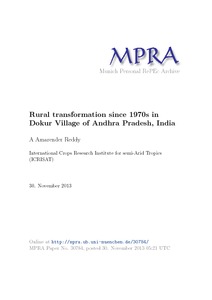Rural transformation since 1970s in Dokur Village of Andhra Pradesh, India
Abstract
In the past two decades, there are significant changes in rural India. There is some significant progress in reduction of poverty. This study examines the pathways by the Dokur villagers of Andhra Pradesh in India to survive and improve livelihoods in the face of a decade of persistent drought. The study is based on quantitative and qualitative data collected by ICRISAT: (a) longitudinal household survey data for the period 1975 to 2009, and (b) information and data gathered through focus group discussions with the villagers. It has documented various types of livelihood strategies, government policies, programs, process and outcomes over the period. The changes in ownership of productive assets including land, cropping patterns, occupational structure, household income, food intake and nutrition, children’s education, and improvement in living standard are also examined. The per capita income of households has increased rapidly in the recent years. However, income inequality situation has worsened as high-income opportunities are favourable to resource endowed households. As a consequence of increased income from multiple sources, consumption level has gone up and consumption has been smoothened, and overall living standard has improved. Access to education particularly for girls and children from marginalized families has increased. Finally, the study identified enabling factors at household level and suggests development policy

